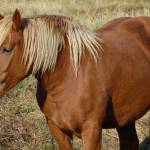Your Horse: Avoid Being Felled by Autumn Founder

If you’ve been involved with horses for any length of time, you’re no stranger to the anguish caused by laminitis. While you may be aware of common causes of founder—grain overload, endocrine disturbances, and overloading of supporting limbs, there’s one you may overlook: autumn grazing.
While spring pastures may contain high levels of sugar that can induce a bout of laminitis, a feeding frenzy in autumn could have the same effect.
“Some rain and a late-summer heatwave, especially after a long, dry summer, can cause pastures to have a growth spurt similar to what happens in the spring. These pastures can have high water-soluble carbohydrate levels, including both sugar and fructan, that may induce laminitis,” explained Catherine Whitehouse, M.S., a Kentucky Equine Research nutrition advisor. “Autumn founder can also occur following the first frost.”
Cool-season forages such as tall fescue continue to grow late in the year, posing a risk for any horse or pony predisposed to developing laminitis. Further, cool-season grasses often experience a dramatic increase in sugar content after a frost.
“Grazing muzzles must be used for at-risk horses even in the auutmn to avoid pasture-associated laminitis,” Whitehouse said.
Using a research-proven buffer such as EquiShure will help minimize changes in hindgut pH, thereby stabilizing the intestinal microbiome.
Considering that laminitis remains one of the most common reasons for euthanasia of horses, all efforts should be directed at hoof health regardless of the season. One study* reports that reasons related to euthanasia were attributed to disease stage, severity, and progression. For example, persistent lameness following a recent bout of laminitis commonly prompted owners to elect humane euthanasia. Or, if a horse had a slow recovery from a laminitic episode, some owners perceived their horses were at risk for future episodes and chose to euthanize.
“Owners were also more likely to elect humane euthanasia if slow recovery necessitated prolonged periods of time in a stall. Owners believed extended stall rest would negatively affect their horse’s psychological well-being and quality of life,” added Whitehouse.
Horses that have recovered from laminitis may benefit from a well-rounded hoof supplement. “Kentucky Equine Research offers high-quality products that include nutrients necessary for growth of strong, resilient hooves, such as biotin, zinc, methionine, and iodine,” shared Whitehouse.
*Pollard, D., C.E. Wylie, J.R. Newton, and K.L.P. Verheyen. 2020. Factors associated with euthanasia in horses and ponies enrolled in a laminitis cohort study in Great Britain. Preventative Veterinary Medicine 174:104833.








